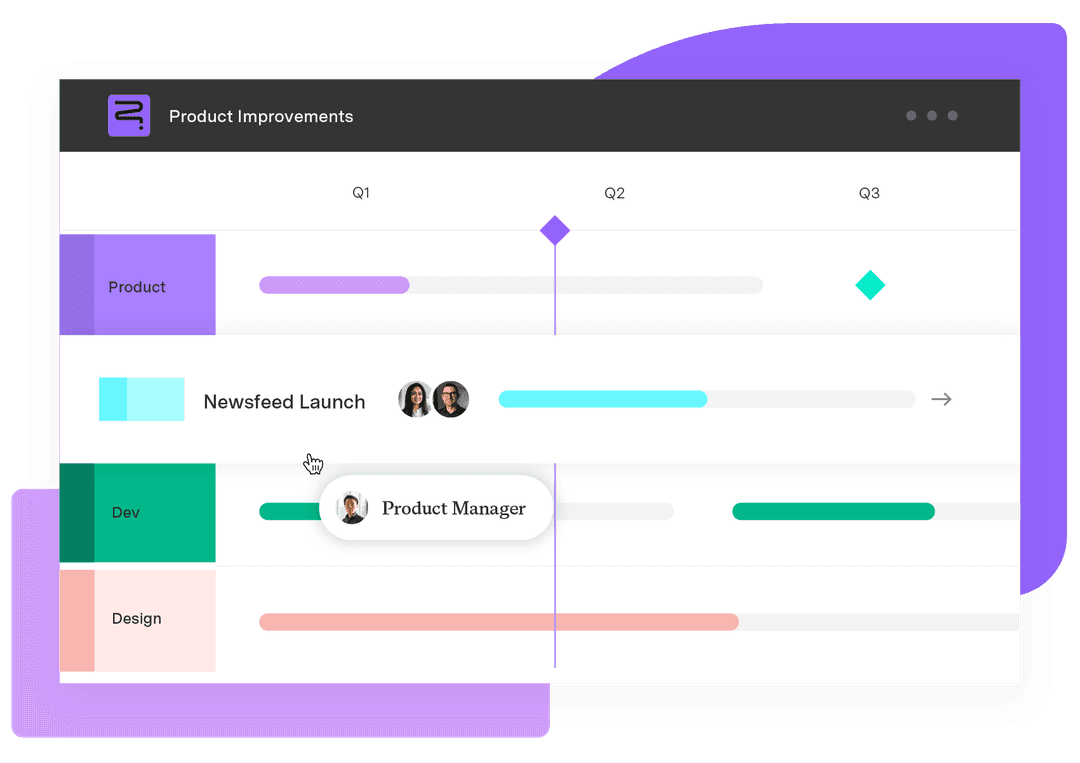How to create a roadmap: Steps, examples, and tips
Tempo Team
A well-crafted roadmap is one of the most versatile tools in project management. This multi-purpose implement functions across disciplines and industries, facilitating communication, illustrating strategy, and focusing effort. Whether you’re working in product development, HR, or marketing, a roadmapping tool delivers excellent outcomes.
Project managers must understand how to create a roadmap to maximize its potential. Fortunately, we’ve got all the info you need.
What is a roadmap?
A roadmap is a high-level communication tool that illustrates the strategy behind an initiative. The document answers critical questions about the following facets:
Required work
Which tasks to prioritize and why
Project team members
Scope and resource needs
Project and product managers often develop tunnel vision when actively managing an initiative, zeroing in on day-to-day operations. A project or product roadmap removes blinders, helping leadership and team members see how everyday activities contribute to business goals and overall success.
A fully realized roadmap communicates essential info, such as:
Strategic alignment: Why and how a project contributes to a high-level business goal or strategy.
Tracking: What metrics will monitor project goals and resource utilization.
Task duration: Project milestones and timelines for the delivery of key outcomes.
Dependencies: Which activities teams must complete before beginning another, who’s involved, and why.
One of the most popular formats is the product roadmap. The roadmap’s visual nature enables product managers to communicate product strategy, evolution, and timelines to stakeholders, securing alignment and buy-in.
Benefits of creating a roadmap
Project roadmaps produce an impressive range of benefits, assisting everyone involved in an initiative. Here are some of the primary advantages for stakeholders, project managers, and their teams:
Provides clarity: The roadmap’s graphic format makes content intuitive, whether communicating timelines to a product team or strategic goals to upper management.
Visualizes goals and strategies: A project with a clear strategic vision, goals, and intent builds alignment, directing team members’ focus toward tasks that productively contribute to the outcome.
Facilitates communication: A roadmap conveys a shared strategy and becomes a point of reference for productive conversations between cross-functional teams about timing, shared resources, and other challenges.
Strategic decision-making: The roadmap’s transparency and focus on high-level strategy assist teams in centering business goals, allowing them to reach an effective consensus about issues impacting the project.
Facilitates prioritization: Focusing the group’s effort on strategy and goals helps identify high-value activities and deliverables. They’ll know when to make compromises and trade-offs to support their production.
Enforces accountability: A roadmap outlines project tasks, desired outcomes, and those responsible for delivery. This transparency encourages team members to meet expectations.
Promotes collaboration: Roadmaps uncover dependencies and bottlenecks, enabling the coordination of complex projects across large, cross-functional teams.
Increases morale: Projects are a group investment of time and energy. Tying team contributions to high-level goals shows members the impact of their effort so they can take pride in their work.
Essential Components of a Roadmap
As the roadmap maker, you’ve got a lot of ground to cover. Whether plotting a strategy roadmap for management or an agile team’s Kanban roadmap, the key elements are identical:
Goals and objectives: Define project value and how delivery advances the organization’s objectives.
Releases and milestones: Establish the project schedule, including the start date, milestones, and deadlines.
Features: Prioritize activities based on their overall value.
Dependencies: Identify interrelated work and how timelines may impact delivery dates.
Including the correct content is critical for an effective roadmap. Specific qualities and characteristics will ensure its success as a communication and planning tool, including:
Flexibility: Strategy isn’t static. Roadmapping tools must adapt outputs to reflect complex, ambiguous, and unknown circumstances.
Collaboration: Include stakeholders and incorporate their input, objections, and concerns into the roadmap to secure buy-in. You can’t say yes to everything, but their feedback can benefit prioritization and improve outcomes.
Engagement: Bright colors and appealing graphics hold stakeholder attention. Visuals communicate relationships between roadmap elements.
Clarity: Projects have many moving parts, so the roadmap must define each task or activity and their relationships.
Detail: Not everyone is interested in a project’s granular details, so tailor the roadmap’s content to its audience. For example, key dates and milestones may satisfy upper management, whereas development teams care more about product features, dependencies, measurable objectives, and strategic plans.
How to create a roadmap
A roadmap template or software does most of the heavy lifting, but you still need to do your part. Here are the basic steps of drafting a project roadmap:
1. Establish project timelines
Your project plan determines the roadmap’s start and end dates, project phases, and timelines for milestones and deliverables. Clarify the project schedule with a Gantt chart that illustrates proposed timelines and identifies potential conflicts.
2. Define deliverables and milestones
Deliverables are the initiative’s tangible products and outcomes. Milestones act as checkpoints marking significant events throughout the project lifecycle.
List expected deliverables and critical milestones, including specific deadlines. Include as much detail as possible to help team members and stakeholders make informed decisions and provide accurate feedback.
3. Identify task dependencies
Identify and document task dependencies using the Gantt chart from the first step. Next, optimize workflows and relieve bottlenecks by prioritizing work to ensure prerequisite completion before initiating a dependent task.
4. Pinpoint project risks
Every project presents unique threats that could derail a successful outcome. Conduct a risk assessment to identify factors that could impact delivery and brainstorm mitigation strategies.
5. Connect with stakeholders
Finally, secure buy-in from key stakeholders by hosting a presentation to introduce the project roadmap. Discuss crucial details, such as:
Project vision and objectives
Project schedule
Deliverables and outcomes
Milestones
Dependencies
Risks
Solicit questions and comments, adjusting the roadmap according to stakeholder feedback. By the session’s end, attendees should understand the project’s goals and their relevance to the organization’s long-term strategy.
Choosing the right roadmap tool
PowerPoint or Excel may produce viable results, but a dedicated roadmap software, such as Tempo’s Strategic Roadmaps application, makes the task more manageable. Here are some essential features of a roadmapping tool that will streamline your project or product management practice:
Ease of use
The best applications provide time-saving tools and automations to simplify roadmap creation and updating. Project and product managers often scramble for time, so they need the capacity to outline and populate a roadmap on the fly.
Adaptability
Every project is different, so you need a roadmapping tool that’s agile enough to personalize every detail and update to reflect shifts in strategy, timelines, and outcomes.
Third-party integrations
Your roadmap software should integrate with your existing tech stack, including project management tools like Atlassian’s Jira. Synchronizing solutions allows you to create new roadmaps using real-time project data. Some solutions include a Refresh feature that automatically adjusts your roadmap whenever the team updates the project plan or other documentation.
Visuals
Roadmaps communicate visually, so your chosen application should include simple, intuitive graphic elements that clearly illustrate information.
Templates
Roadmapping can be labor-intensive. Templates speed up the process while ensuring the completion of all critical steps. For example, Tempo’s Strategic Roadmaps application includes business, agile, technology, and product roadmap templates.
Best practices for creating roadmaps
Understanding goals, resource allocations, and timeframes creates the foundation for a great project roadmap. But that’s only the start. Consider incorporating the following roadmapping best practices.
Focus on the “why”
A roadmap’s primary goal is capturing and communicating project or product vision. However, the reasoning behind a strategy is as important as its implementation, so address purpose and direction by explaining why this initiative benefits the company.
Simplify
Avoid cluttering the roadmap with irrelevant information. Instead of relying on text to represent high-level information, use visuals and colors to communicate strategy and ideas.
Share
Ensure clarity regarding expectations by giving stakeholders access to the roadmap and encouraging them to routinely contribute commentary and questions.
Update
Futureproof your roadmaps by ensuring they can adjust to shifting circumstances. Regular updates guarantee team members work with current information and avoid costly mistakes.
Be realistic
Keep roadmaps practical. A lofty goal may impress stakeholders, but you risk disappointing them and damaging your reputation if you can’t deliver. Instead, set achievable goals based on team capacity, resources, and time.
Communicating your roadmap effectively
Keep these factors in mind, and you’ll crush your roadmap presentation, no matter who’s in the audience:
Awareness: Tailor your discussion to suit your audience and your desired outcome.
Agenda: Meet attendee expectations by creating a checklist of relevant discussion topics.
Purpose: Take a goal-first approach to developing your presentation. Demonstrate why the information should interest your audience, then determine the intended takeaways and your desired feedback.
Vision: Provide strategic context by including information on business models, goals, personas, and the competitive environment.
Feedback: A question-and-answer segment provides insight into the roadmap’s effectiveness, allowing you to iterate and improve.
Distribution: Leverage the roadmap’s communication ability by giving access to the document and establishing an update schedule to keep it current.
Elevate your roadmapping with Tempo
Tempo’s Strategic Roadmaps application has everything you need to create dynamic project and product roadmaps that effectively communicate strategy, prioritizations, and timelines.
Strategic Roadmaps integrates seamlessly with Jira project management, allowing users to create boardroom-ready presentations in minutes. The solution also combines a portfolio of projects into one comprehensive roadmap, showing how their combined effort contributes to company objectives. Try Tempo and upgrade your project planning.













































